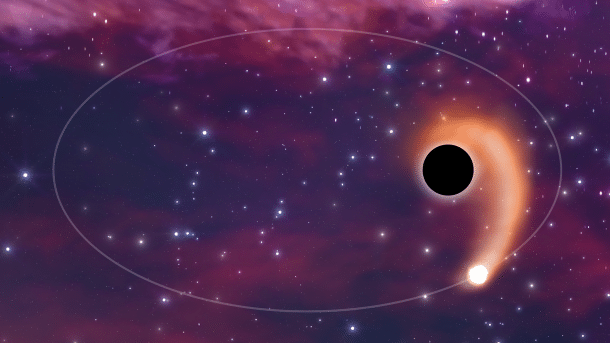Astronomy: Black hole devours same star in several stages
A research team has made a spectacular discovery: A black hole that repeatedly snatches pieces from a star without swallowing it.

(Bild: ESA, CC BY-SA 3.0 IGO)
(Hier finden Sie die deutsche Version des Beitrags)
Using the now-deactivated eRosita space telescope, a research team has discovered a black hole that periodically swallows parts of the same star, but which survives each of these "meals." As the Max Planck Institute for Extraterrestrial Physics (MPE) explains, the "spectacular" process was discovered during a sky survey of an otherwise unremarkable galaxy a billion light-years away. Immense X-ray bursts would be observed there altogether three times in a rhythm repeating approximately every 220 days. The star had always lost only a few percent of the mass of our sun and had therefore survived the approaches.
Star withstands immense forces
(Bild: MPE)
When a star gets too close to the supermassive black hole at the center of a galaxy and is ripped apart by tidal forces, researchers call this a "tidal disruption event." They can be observed as bright flashes in the UV and X-ray spectra, MPE explains. Because they occur only about every 10,000 years per galaxy, such events are also comparatively rare to observe overall. Recurrent outbursts are correspondingly rarer, and only recently has evidence of them been discovered. In such cases, the stars survive the unimaginable forces and lose only part of their outer layers. The black hole is fed, but does not devour the whole star. By observing such cases, the growth of such black holes could be better studied.
The now presented source named J0456-20 was found during a survey of the entire sky. eRosita searches for variable objects and found it in February 2021. The X-ray observation alone suggests that it is the same star that it is gradually decaying. In addition, however, the phenomenon had also been observed in the radio range with antennas in Australia and thus further features had been found that support this interpretation. With further observations the physical processes are to be investigated still more exactly. In addition, it is an ideal laboratory "to test general relativity in very strong gravitational fields," adds eRosita's research director Andrea Merloni. A research article on the find has now been published in the journal Astronomy & Astrophysics.
The X-ray telescope eRosita (extended Roentgen Survey with an Imaging Telescope Array) can map the entire X-ray sky with unprecedented depth. It completed its first full survey in mid-2020. It is installed alongside the Russian ART-XC telescope on the Spectrum X-ray Gamma (Spektr-RG) spacecraft. German officials decided to shut down the instrument in early 2022 in response to Russia's war of aggression against Ukraine. Since then, it has not been conducting research. However, data already collected continues to be analyzed. A review of eRosita's condition began in mid-November, the MPE had said. It is unclear how long it will last.
(mho)